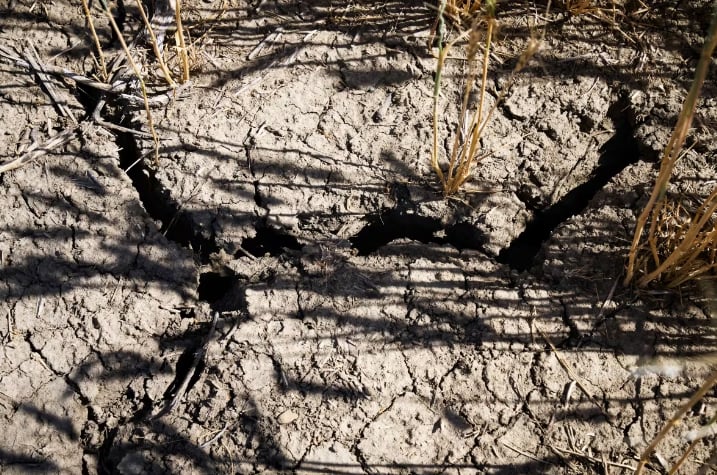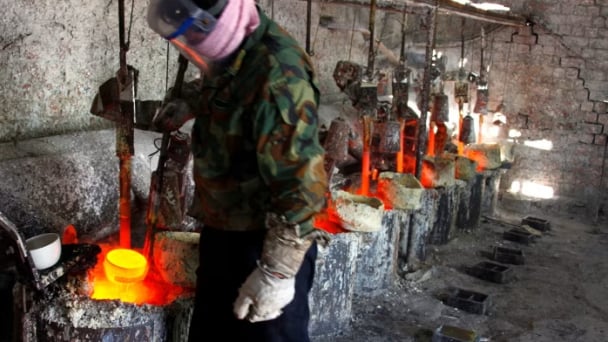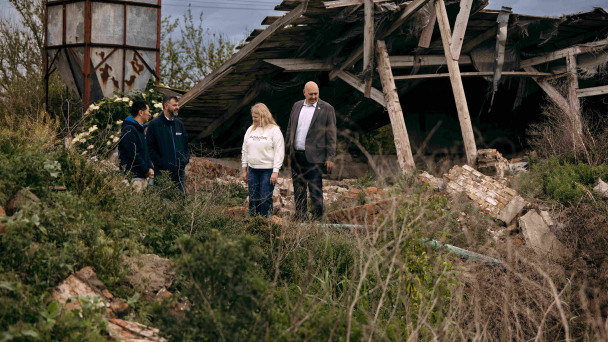June 21, 2025 | 03:19 GMT +7
June 21, 2025 | 03:19 GMT +7
Hotline: 0913.378.918
June 21, 2025 | 03:19 GMT +7
Hotline: 0913.378.918

The cracked dry land of farmer Sean Stanford’s wheat field that is suffering from lack of rain and high summer temperatures is shown near Magrath, Alta. Photo: Todd Korol/The Canadian Press
Sean Stanford's wheat farm just south of Lethbridge, Alta. falls within the far left corner of Palliser's Triangle — an expanse of prairie grassland encompassing much of southeast Alberta, a swath of southern Saskatchewan, and the southwest corner of Manitoba.
The area is named for explorer Capt. John Palliser, who in 1857, famously declared the entire region a wasteland — so hot and arid that no crops would ever grow.
More than 160 years later, with parts of the prairie provinces suffering through another summer of drought conditions, Stanford's farm is certainly dry.
"I think we've had three inches of rain since we started seeding. It's been pretty dismal, honestly," he said in an interview in July.
But Stanford is growing crops, thanks to a series of small sprinklers, attached to a large pipe and powered by an electric motor that disperse water from a nearby irrigation canal over some of his fields.
"Hopefully this fall I'm going to put up a little more irrigation on a couple more fields of mine," Stanford said, adding he expects his non-irrigated, or dryland, acres to yield about a third of what his irrigated acres yield this year.
"You're able to mitigate your risks a lot more. Moisture, in my mind, is the No. 1 driving factor in making a crop or not."
The economy of southern Alberta would not exist as it does today without irrigation. As early as the late 1800s, public and private investors began to build a vast network of dams, reservoirs, canals and pipelines that opened the area up for settlement and turned John Palliser's so-called wasteland into a viable farming region.
According to the Alberta WaterPortal Society, there are now more than 8,000 kilometres of conveyance works and more than 50 water storage reservoirs devoted to managing 625,000 hectares of irrigated land in the province.
And while that's just over five per cent of the province's total agricultural land base, it accounts for 19 per cent of Alberta's gross primary agricultural production. Farmers in irrigation districts are able to produce high-value, specialized crops such as sugar beets and greenhouse vegetables.
"There are places that we simply wouldn't have an agriculture industry if irrigation wasn't happening — parts of the province are so dry that we wouldn't be growing anything," said Richard Phillips, general manager of the Bow River Irrigation District, which owns and operates several hundred kilometres of earth canals and water pipelines, as well as several reservoirs, in the Vauxhall area southeast of Calgary.
"We certainly wouldn't be growing the crops that are being grown."
In drier-than-normal years — like the one southeast Alberta is experiencing right now — irrigation is often the only thing standing in the way of full-fledged agricultural disaster, Phillips added.
"If it's a drought year, dryland produces next to nothing, whereas the irrigated areas are still producing excellent crops," Phillips said.
"It's great drought insurance, if you want to think of it that way."
According to Agriculture and Agri-Food Canada's most recent drought monitor report, 76 per cent of the country's agricultural landscape is either abnormally dry or experiencing moderate to severe drought this summer.
Some farmers, depending on the region, are dealing with their third or even fourth consecutive year of drought — with 2021 being an exceptionally bad year that saw production of some crops in Canada fall to their lowest level in more than a decade.
That's part of the reason behind a recent push to modernize and expand irrigation infrastructure in this country.
In Alberta, in 2020, the province and the federal government through the Canada Infrastructure Bank announced a $932-million project to rehabilitate older irrigation equipment in the province, as well as construct or enlarge up to four off-stream irrigation storage reservoirs.
Saskatchewan has also announced a $4-billion project to double the amount irrigable land in the province.
Agriculture Canada predicts that changes in temperature and precipitation patterns due to climate change will increase reliance on irrigation and water-resource management in years to come — most notably across the Prairies and the interior of British Columbia, but "also in regions where there has not traditionally been a need to irrigate."
Jodie Parmar, head of project development for Western Canada with the Canada Infrastructure Bank, said even Ontario and some of the Atlantic provinces have expressed interest in exploring irrigation projects recently.
"When I engaged in 2020 with provincial governments, in Western Canada in particular, what I heard from them was the need to focus on agriculture and agri-food," Parmar said.
"And within that sub-sector, irrigation was their top ask."
Parmer said irrigation can not only be used to bring water to areas that don't have enough, it can also improve the usage of the water that is available.
With climate change, for example, glaciers high in the Rocky Mountains are melting earlier in the season — and not at the time of year when farmers actually need the resulting runoff water. With irrigation, the water from those early-melting glaciers can be diverted and harnessed in reservoirs to be used for agriculture when it's actually needed.
But not everyone believes irrigation can solve all of agriculture's woes — at least, not without a price.
Even with effective water use management, there's a limit to how much water can be drawn from a single source — and a limit to how much expansion of irrigation the public will tolerate, said Maryse Bourgault, an agronomist at the University of Saskatchewan
"In Saskatchewan, (advocates) talk about Lake Diefenbaker being used for irrigation. But Lake Diefenbaker is also very much involved in tourism," she said.
"So how will the general public feel about us draining Lake Diefenbaker for irrigation?"
Bourgault added that over-irrigating can also raise the water table of the soil, and when that water evaporates, it leaves salts behind. She said in parts of the world, landscapes and ecosystems have suffered long-term damage.
"So I don't believe (that it is a solution)," Bourgault said.
"I think at some point you're going to overdo it. Even if you have the best management, at some point, nature happens."
Irrigation is currently responsible for about 70 per cent of freshwater withdrawals worldwide. According to the Princeton Environmental Institute, about 90 per cent of water taken for residential and industrial uses eventually returns to the aquifer, but only about one-half of the water used for irrigation is reusable.
The remainder evaporates, is lost through leaky pipes or otherwise removed from the water cycle.
Bourgault said instead of expanding irrigation, farmers should be seeking to mitigate the effects of climate change through improved crop genetics and alternative farming practices like cover cropping, which can reduce the amount of moisture lost through evaporation.
Still, for farmers like Stanford, who have spent much of this past summer anxiously watching heat-shimmering skies for any hint of rain, irrigation is nothing less than a lifeline.
"If they could get some irrigation acres opened up all the way to the Saskatchewan border and beyond, that would be a huge benefit," Stanford said.
"To have more moisture, if it's not going to rain anymore around here, is going to be the saving grace for agriculture in this area."
(CBC)

(VAN) Poultry production in Poland, which has only started recovering from devastating bird flu outbreaks earlier this year, has been hit by a series of outbreaks of Newcastle disease, with the veterinary situation deteriorating rapidly.

(VAN) Extensive licensing requirements raise concerns about intellectual property theft.

(VAN) As of Friday, a salmonella outbreak linked to a California egg producer had sickened at least 79 people. Of the infected people, 21 hospitalizations were reported, U.S. health officials said.

(VAN) With the war ongoing, many Ukrainian farmers and rural farming families face limited access to their land due to mines and lack the financial resources to purchase needed agricultural inputs.

(VAN) Vikas Rambal has quietly built a $5 billion business empire in manufacturing, property and solar, and catapulted onto the Rich List.

(VAN) Available cropland now at less than five percent, according to latest geospatial assessment from FAO and UNOSAT.

(VAN) Alt Carbon has raised $12 million in a seed round as it plans to scale its carbon dioxide removal work in the South Asian nation.